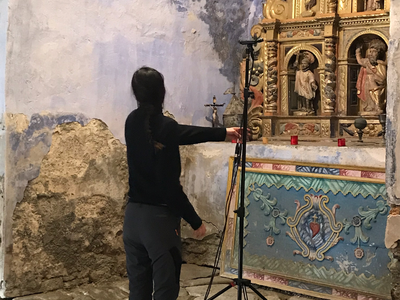Studying the sounds of the past means taking an interest in a material that no longer exists, reconstructing traces, testing hypotheses, but also allowing for interpretations. The ‘divided heritage’ of the Romanesque churches in the Catalan Pyrenees prompts the inquiry of work decontextualisation, atmospheric fragmentation, and historical evolution through an in situ return that primarily stimulates the senses as a cognitive instrument.
Many churches and hermitages dating back to the 11th and 12th centuries can be found in the valleys of the Catalan Pyrenees. Filled with murals, music, words and silence throughout their history, they are now mostly closed. At the beginning of the 20th century, to limit sales to North American art collectors, measures were taken to remove the murals. Transported from the mountains to the regional capital, they were then permanently installed in the National Art Museum of Catalonia. While the paintings may have been moved, the world of sound that once enveloped them is still present in situ.
These churches have a history of practices that originate from a tradition that is both sacred and pagan, providing space for prayer, refuge, and entertainment.The murals show a close link with the sound practices of the place. For example, the iconography of the church of Sant Joan de Boí features a juggler playing a stringed instrument, while the paintings of Sant Romà de les Bons show figures reacting to the sacred message through their exaggeratedly visible ears.The frescoes at the bottom of the walls, depicting backdrops for liturgical dramas, are also in question. But what sound space did these images bathe in?
Today, the artistic value and heritage interest of these murals are unanimously recognised, but this does not prevent most of the churches that housed them from deteriorating and ceasing to have any activity that brings them to life. And yet their acoustic qualities are obvious when voices or music are heard there again. If today the issue of returning the paintings is not currently relevant due to potential conservation risks, how can we bring this ‘divided’ heritage to life, if not by activating its sensitive part and its eminently narrative dimension?The idea is to restore meaning to these churches through the historical, geographical and societal paths that link them to their paintings. We’re operating under the premise that sound and walking are potent sensory experiences for comprehending this heritage, and envisioning modern creations* to forge fresh connections.
*For example, the work of musician Arnau Obiols in the churches of Sant Pere and Sant Pau de Esterri de Cardós and Santa Maria in Ginestarre, during one of our research visits.
See also: Cerisy Days
